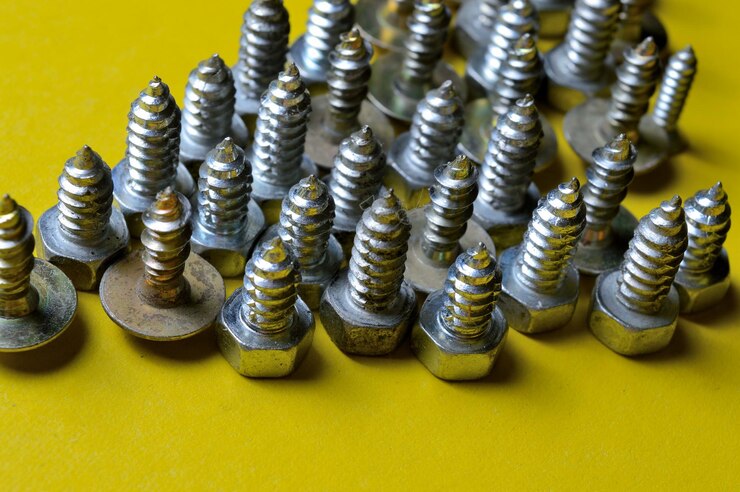304 screws are renowned for their durability, corrosion resistance, and versatility. Made from an alloy containing 18% chromium and 8% nickel, these screws are an essential component in various industries. Their unique composition makes them ideal for environments where moisture and corrosive elements are present.
Properties of 304 Stainless Steel Screws
Corrosion Resistance
One of the most notable properties of 304 stainless steel screws is their exceptional corrosion resistance. The presence of chromium forms a passive layer of chromium oxide, which prevents further surface corrosion and blocks corrosion from spreading into the metal’s internal structure.
High Tensile Strength
304 stainless steel screws possess high tensile strength, making them suitable for applications that require strong and durable fasteners. This property ensures that they can withstand significant stress without deforming or breaking, thus providing long-lasting performance.
Non-Magnetic Nature
While 304 stainless steel screws are generally non-magnetic, they can become slightly magnetic when worked or cold-formed. However, this magnetism is usually minimal and does not affect their corrosion resistance or overall performance.
Excellent Weldability and Formability
304 stainless steel screws can be easily welded and formed into various shapes without losing their structural integrity. This makes them ideal for custom applications where specific screw designs are required.
Applications of 304 Stainless Steel Screws
Marine Environments
Given their superior corrosion resistance, 304 stainless steel screws are extensively used in marine environments. They are ideal for boat building, dock construction, and other applications where exposure to saltwater is common.
Food and Beverage Industry
304 stainless steel screws are commonly used in the food and beverage industry due to their resistance to corrosion and staining. They are utilized in equipment such as food processors, brewing systems, and kitchen appliances.
Construction and Architecture
In the construction and architecture sectors, 304 stainless steel screws are valued for their strength and aesthetic appeal. They are used in structural components, decorative fixtures, and outdoor installations where both durability and appearance are important.
Medical Devices
The biocompatibility of 304 stainless steel makes it suitable for use in medical devices. Screws made from this material are used in surgical instruments, implants, and other medical equipment that require high standards of hygiene and corrosion resistance.
Benefits of Using 304 Stainless Steel Screws
Longevity and Reliability
The combination of corrosion resistance and high tensile strength ensures that 304 stainless steel screws offer longevity and reliability. They can withstand harsh conditions and maintain their integrity over time, reducing the need for frequent replacements.
Versatility in Applications
304 stainless steel screws are incredibly versatile, making them suitable for a wide range of applications. Their ability to be easily formed and welded allows for custom solutions in various industries, enhancing their utility.
Cost-Effective Solution
Despite their premium properties, 304 stainless steel screws are a cost-effective solution. Their durability and resistance to wear and tear minimize maintenance costs, providing long-term savings compared to other materials that may require frequent replacement.
Aesthetic Appeal
304 stainless steel screws have a clean, polished finish that adds an aesthetic appeal to any project. This makes them an excellent choice for applications where appearance matters, such as in architectural designs and consumer products.
Comparison with Other Types of Stainless Steel Screws
304 vs. 316 Stainless Steel Screws
While both 304 and 316 stainless steel screws offer excellent corrosion resistance, 316 screws contain molybdenum, which enhances their resistance to chlorides and other industrial solvents. This makes 316 screws more suitable for highly corrosive environments, such as chemical processing plants. However, 304 screws are more commonly used due to their sufficient corrosion resistance for most applications and their lower cost.
304 vs. 410 Stainless Steel Screws
410 stainless steel screws are martensitic, meaning they can be heat-treated for increased strength and hardness. However, they do not offer the same level of corrosion resistance as 304 stainless steel screws. 410 screws are often used in applications requiring high strength but where exposure to corrosive elements is minimal.
304 vs. 430 Stainless Steel Screws
430 stainless steel screws are ferritic and contain less nickel than 304 screws, which makes them less corrosion-resistant. However, they are more affordable and are used in applications where high corrosion resistance is not as critical. 304 screws are preferred when a balance of corrosion resistance, strength, and affordability is needed.
Maintenance Tips for 304 Stainless Steel Screws
Regular Inspection
Regular inspection of 304 stainless steel screws is crucial to ensure their integrity and performance. Look for signs of wear, corrosion, or damage, and replace any compromised screws promptly to maintain the safety and functionality of the assembly.
Proper Cleaning
To maintain the corrosion resistance and aesthetic appeal of 304 stainless steel screws, proper cleaning is essential. Use mild soap and water or a specialized stainless steel cleaner to remove dirt and debris. Avoid using harsh chemicals or abrasive materials that could damage the passive oxide layer.
Correct Installation
Ensure that 304 stainless steel screws are installed correctly using the appropriate tools and techniques. Over-tightening can cause deformation, while under-tightening can lead to loosening and potential failure. Following the manufacturer’s guidelines for torque specifications is important for optimal performance.
Conclusion
304 stainless steel screws are a versatile and reliable choice for various industries and applications. Their corrosion resistance, high tensile strength, excellent formability, and cost-effectiveness make them a preferred option for both standard and specialized uses. By understanding their properties and benefits, you can make informed decisions to enhance the durability and performance of your projects.
Read Also:

